At the forefront of science: an analysis of articles arxiv.org
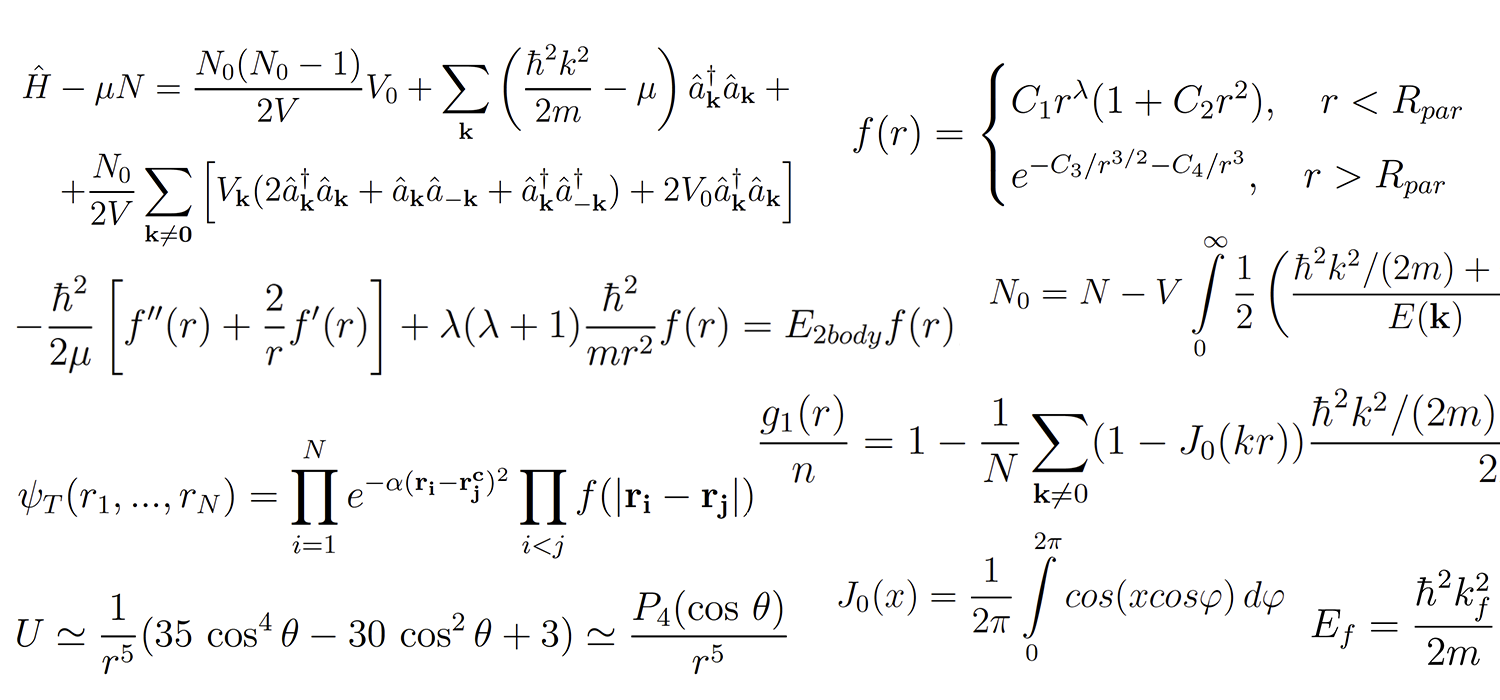
My specialty is condensed matter physics. Of course, in the process of immersion into it, it is required to study many scientific articles, however, at least one analysis can take a lot of time. On arxiv, over a thousand articles per month are published in the cond-mat section . There is a situation when many researchers, especially beginners, do not have a holistic vision of their field of science. The tool described in this article summarizes the contents of the scientific articles base and is intended to speed up the work with literature.
It is worth making a reservation that we are reinventing the wheel, only ours will ride for free (prices for paid counterparts are so indecent that they are not taken to be indicated).
Cyclists will be built in Python, for topical use simulation Gensim , to visualize Plot.ly . At the end of the article are links to Jupyter laptops and GitHub.
The source material for the work - annotations and texts of scientific articles. If the first ones are available to us in the “finished” XML form, then PDF files of articles need to be converted to txt, as a result of this process a lot of “garbage” remains in the texts, so they need to be seriously cleaned.
Sample annotation
<?xml version="1.0" encoding="UTF-8"?><feedxmlns="http://www.w3.org/2005/Atom"><linkhref="http://arxiv.org/api/query?search_query%3D%26id_list%3D1706.09062%26start%3D0%26max_results%3D10"rel="self"type="application/atom+xml"/><titletype="html">ArXiv Query: search_query=&id_list=1706.09062&start=0&max_results=10</title><id>http://arxiv.org/api/ECEwpFhuO79sa+LzMzx6/iStFak</id><updated>2018-05-01T00:00:00-04:00</updated><opensearch:totalResultsxmlns:opensearch="http://a9.com/-/spec/opensearch/1.1/">1</opensearch:totalResults><opensearch:startIndexxmlns:opensearch="http://a9.com/-/spec/opensearch/1.1/">0</opensearch:startIndex><opensearch:itemsPerPagexmlns:opensearch="http://a9.com/-/spec/opensearch/1.1/">10</opensearch:itemsPerPage><entry><id>http://arxiv.org/abs/1706.09062v1</id><updated>2017-06-27T22:03:24Z</updated><published>2017-06-27T22:03:24Z</published><title>On Bose-Einstein condensation and superfluidity of trapped photons with
coordinate-dependent mass and interactions</title><summary> The condensate density profile of trapped two-dimensional gas of photons in
an optical microcavity, filled by a dye solution, is analyzed taking into
account a coordinate-dependent effective mass of cavity photons and
photon-photon coupling parameter. The profiles for the densities of the
superfluid and normal phases of trapped photons in the different regions of the
system at the fixed temperature are analyzed. The radial dependencies of local
mean-field phase transition temperature $T_c^0 (r)$ and local
Kosterlitz-Thouless transition temperature $T_c (r)$ for trapped microcavity
photons are obtained. The coordinate dependence of cavity photon effective mass
and photon-photon coupling parameter is important for the mirrors of smaller
radius with the high trapping frequency, which provides BEC and superfluidity
for smaller critical number of photons at the same temperature.
We discuss a possibility of an experimental study of the density profiles for
the normal and superfluid components in the system under consideration.
</summary><author><name>Oleg L. Berman</name></author><author><name>Roman Ya. Kezerashvili</name></author><author><name>Yurii E. Lozovik</name></author><arxiv:doixmlns:arxiv="http://arxiv.org/schemas/atom">10.1364/JOSAB.34.001649</arxiv:doi><linktitle="doi"href="http://dx.doi.org/10.1364/JOSAB.34.001649"rel="related"/><arxiv:commentxmlns:arxiv="http://arxiv.org/schemas/atom">14 page 5, figures</arxiv:comment><linkhref="http://arxiv.org/abs/1706.09062v1"rel="alternate"type="text/html"/><linktitle="pdf"href="http://arxiv.org/pdf/1706.09062v1"rel="related"type="application/pdf"/><arxiv:primary_categoryxmlns:arxiv="http://arxiv.org/schemas/atom"term="cond-mat.mes-hall"scheme="http://arxiv.org/schemas/atom"/><categoryterm="cond-mat.mes-hall"scheme="http://arxiv.org/schemas/atom"/></entry></feed>Sample text
On Bose-Einstein condensation and superfluidity of trapped photons with
coordinate-dependent mass and interactions
Oleg L. Berman1,2, Roman Ya. Kezerashvili1,2, and Yurii E. Lozovik3,4
1Physics Department, New York City College of Technology, The City University of New York,
2The Graduate School and University Center, The City University of New York,
Brooklyn, NY 11201, USA
3Institute of Spectroscopy, Russian Academy of Sciences, 142190 Troitsk, Moscow, Russia
4National Research University Higher School of Economics, Moscow, Russia
New York, NY 10016, USA
(Dated: June 29, 2017)
The condensate density profile of trapped two-dimensional gas of photons in an optical micro-
cavity, filled by a dye solution, is analyzed taking into account a coordinate-dependent effective
mass of cavity photons and photon-photon coupling parameter. The profiles for the densities of the
superfluid and normal phases of trapped photons in the different regions of the system at the fixed
temperature are analyzed. The radial dependencies of local mean-п¬Ѓeld phase transition temperature
T 0
c (r) and local Kosterlitz-Thouless transition temperature Tc(r) for trapped microcavity photons
are obtained. The coordinate dependence of cavity photon effective mass and photon-photon cou-
pling parameter is important for the mirrors of smaller radius with the high trapping frequency,
which provides BEC and superfluidity for smaller critical number of photons at the same temper-
ature. We discuss a possibility of an experimental study of the density profiles for the normal and
superfluid components in the system under consideration.
Key words: Photons in a microcavity; Bose-Einstein condensation of photons; superfluidity of
photons.
PACS numbers: 03.75.Hh, 42.55.Mv, 67.85.Bc, 67.85.Hj
I.
INTRODUCTION
When a system of bosons is cooled to low temperatures, a substantial fraction of the particles spontaneously occupy
the single lowest energy quantum state. This phenomenon is known as Bose-Einstein condensation (BEC) and its
occurs in many-particle systems of bosons with masses m and temperature T when the de Broglie wavelength of the
Bose particle exceeds the mean interparticle distance [1]. The most remarkable consequence of BEC is that there
should be a temperature below which a finite fraction of all the bosons “condense” into the same one-particle state
with macroscopic properties described by a single condensate wavefunction, promoting quantum physics to classical
time- and length scales.
Most recently, the observations at room temperature of the BEC of two-dimensional photon gas confined in an optical
microcavity, formed by spherical mirrors and filled by a dye solution, were reported [2–5]. The interaction between
microcavity photons is achieved through the interaction of the photons with the non-linear media of a microcavity,
п¬Ѓlled by a dye solution. While the main contribution to the interaction in the experiment, reported in Ref. 2, is
thermooptic, it is not a contact interaction.
It is known that BEC for bosons can exist without particle-particle
interactions [6] (see Ref. 1 for the details), but at least the interactions with the surrounding media are necessary to
achieve thermodynamical equilibrium. For photon BEC it can be achieved by interaction with incoherent phonons [7].
The influence of interactions on condensate-number fluctuations in a BEC of microcavity photons was studied in Ref. 8.
The kinetics of photon thermalization and condensation was analyzed in Refs. 9–11. The kinetics of trapped photon
gas in a microcavity, п¬Ѓlled by a dye solution, was studied, and, a crossover between driven-dissipative system laser
dynamics and a thermalized Bose-Einstein condensation of photons was observed [12].
In previous theoretical studies the equation of motion for a BEC of photons confined by the axially symmetrical
trap in a microcavity was obtained.
It was assumed that the changes of the cavity width are much smaller than
the width of the trap [13]. This assumption results in the coordinate-independent effective photon mass mph and
photon-photon coupling parameter g. In this Paper, we study the local superfluid and normal density profiles for
trapped two-dimensional gas of photons with the coordinate-dependent effective mass and photon-photon coupling
parameter in a an optical microcavity, п¬Ѓlled by a dye solution. We propose the approach to study the local BEC
and local superfluidity of cavity photon gas in the framework of local density approximation (LDA) in the traps of
larger size without the assumption, that total changes of the cavity width are much smaller than the size of the trap.
In this case, we study the effects of coordinate-dependent effective mass and photon-photon coupling parameter on
the superfluid and normal density profiles as well as the profiles of the local temperature of the phase transition for
trapped cavity photons. Such approach is useful for the mirrors of smaller radius with the high trapping frequency,
2
which provide BEC and superfluidity for smaller critical number of photons at the same temperature.
The paper is organized in the following way.
In Sec. II, we obtain the condensate density profile for trapped
microcavity photon BEC with locally variable mass and interactions. The expression for the number of particles in a
condensate is analyzed in Sec. III. In Sec. IV, the dependence of the condensate parameters on the geometry of the
trap is discussed. In Sec. V, we study the collective excitation spectrum and superfluidity of 2D weakly-interacting
Bose gas of cavity photons. The results of our calculations are discussed in Sec. VI. The proposed experiment for
measuring the distribution of the local density of a photon BEC is described in Sec. VII. The conclusions follow in
Sec. VIII.
II. THE CONDENSATE DENSITY PROFILE
While at finite temperatures there is no true BEC in any infinite untrapped two-dimensional (2D) system, a true
2D BEC quantum phase transition can be obtained in the presence of a confining potential [14, 15]. In an infinite
translationally invariant two-dimensional system, without a trap, superfluidity occurs via a Kosterlitz−Thouless
superfluid (KTS) phase transition [16]. While KTS phase transition occurs in systems, characterized by thermal
equilibrium, it survives in a dissipative highly nonequilibrium system driven into a steady state [17].
The trap for the cavity photons can be formed by the concave spherical mirrors of the microcavity, that provide
the axial symmetry for a trapped gas of photons. Thus the transverse (along xy plane of the cavity) confinement
of photons can be achieved by using an optical microcavity with a variable width. Let us introduce the frame of
reference, where zв€’axis is directed along the axis of cavity mirrors, and (x, y) plane is perpendicular to this axis. The
energy spectrum E(k) for small wave vectors k of photons, confined in z direction in an ideal microcavity with the
coordinate-dependent width L(r), is given by [2]
E(k) =
ВЇhПЂcЛњn
...
[23] L. Onsager, “Statistical Hydrodynamics,” Nuovo Cimento Suppl. 6, 279 (1949).
[24] R. P. Feynman, “Application of Quantum Mechanics to Liquid Helium,” Prog. Low Temp. Phys. 1, 17 (1955).
[25] P. C. Hohenberg and P. C. Martin, “Microscopic Theory of Superfluid Helium,” Ann. Phys. 34, 291 (1965).
[26] G. Blatter, M. Y. FeigelвЂman, Y. B. Geshkenbein, A. I. Larkin, and V. M. Vinokur, “Vortices in high-temperature super-
conductors,” Rev. Mod. Phys. 66, 1125 (1994).
[27] N. S. Voronova and Yu. E. Lozovik, “Excitons in cores of exciton-polariton vortices,” Phys. Rev. B 86, 195305 (2012);
N. S. Voronova, A. A. Elistratov, and Yu. E. Lozovik, “Detuning-Controlled Internal Oscillations in an Exciton-Polariton
Condensate,” Phys. Rev. Lett. 115, 186402 (2015) .
[28] A. Griffin, “Conserving and gapless approximations for an inhomogeneous Bose gas at finite temperatures,” Phys. Rev. B
53, 9341 (1996).
[29] A. A. Abrikosov, L. P. Gorkov and I. E. Dzyaloshinski, Methods of Quantum Field Theory in Statistical Physics (Prentice-
Hall, Englewood Cliffs. N.J., 1963).
[30] O. L. Berman, Yu. E. Lozovik, and D. W. Snoke, “Theory of Bose-Einstein condensation and superfluidity of two-
dimensional polaritons in an in-plane harmonic potential,” Phys. Rev. B 77, 155317 (2008).
[31] O. L. Berman, R. Ya. Kezerashvili, and K. Ziegler, “Superfluidity and collective properties of excitonic polaritons in gapped
graphene in a microcavity”, Phys. Rev. B 86, 235404 (2012).
[32] A. Amo, J. Lefr`ere, S. Pigeon, C. Adrados, C. Ciuti, I. Carusotto, R. Houdr´e, E. Giacobino, and A. Bramati, “Superfluidity
of polaritons in semiconductor microcavities,” Nature Physics 5, 805 (2009).
[33] J. P. Fern´andez and W. J. Mullin, “The Two-Dimensional Bose−Einstein Condensate,” J. Low. Temp. Phys. 128, 233
From the annotations we will need information only about the authors and subsections of the articles.
Below, as an example, we consider an array of articles from the cond-mat section for 2017. Everything described is easy to reproduce for any other section.
The simplest way to start researching texts is to make a list of keywords of interest to us and calculate the percentage of articles in which they are found.
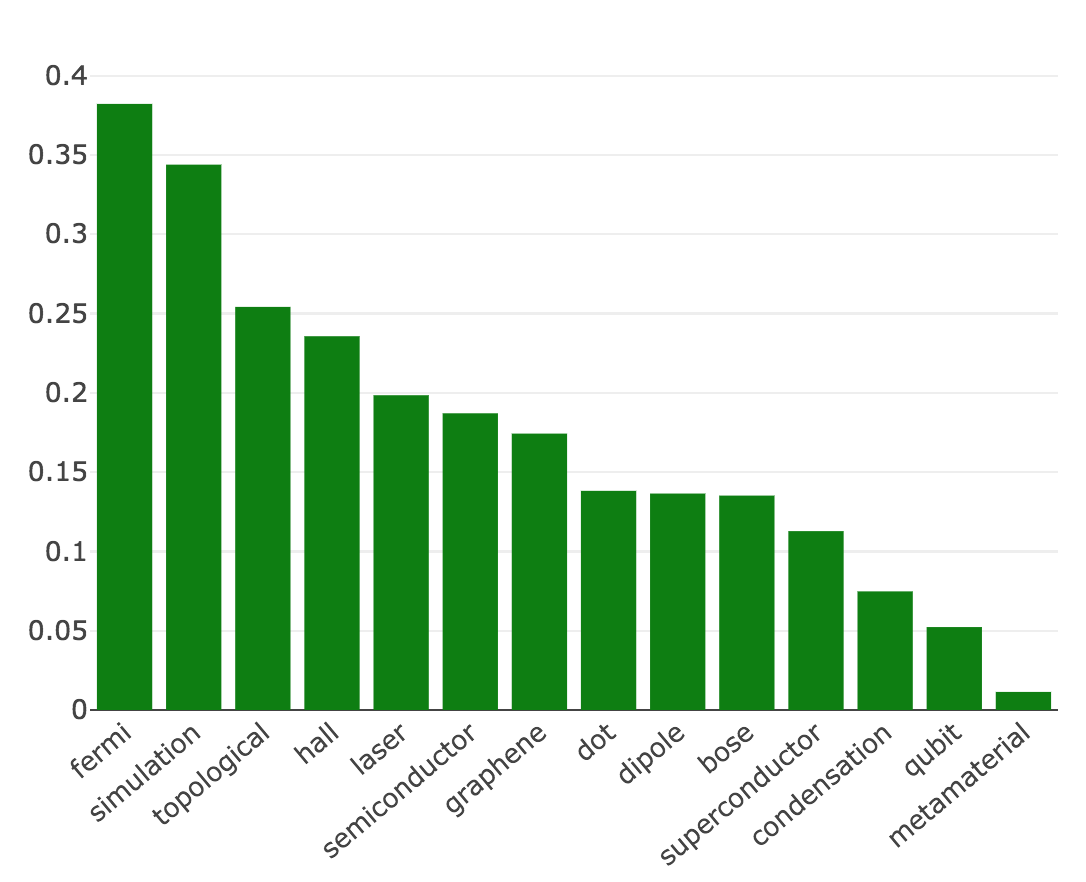
Let us estimate the change in share, for example, compared to 2010.
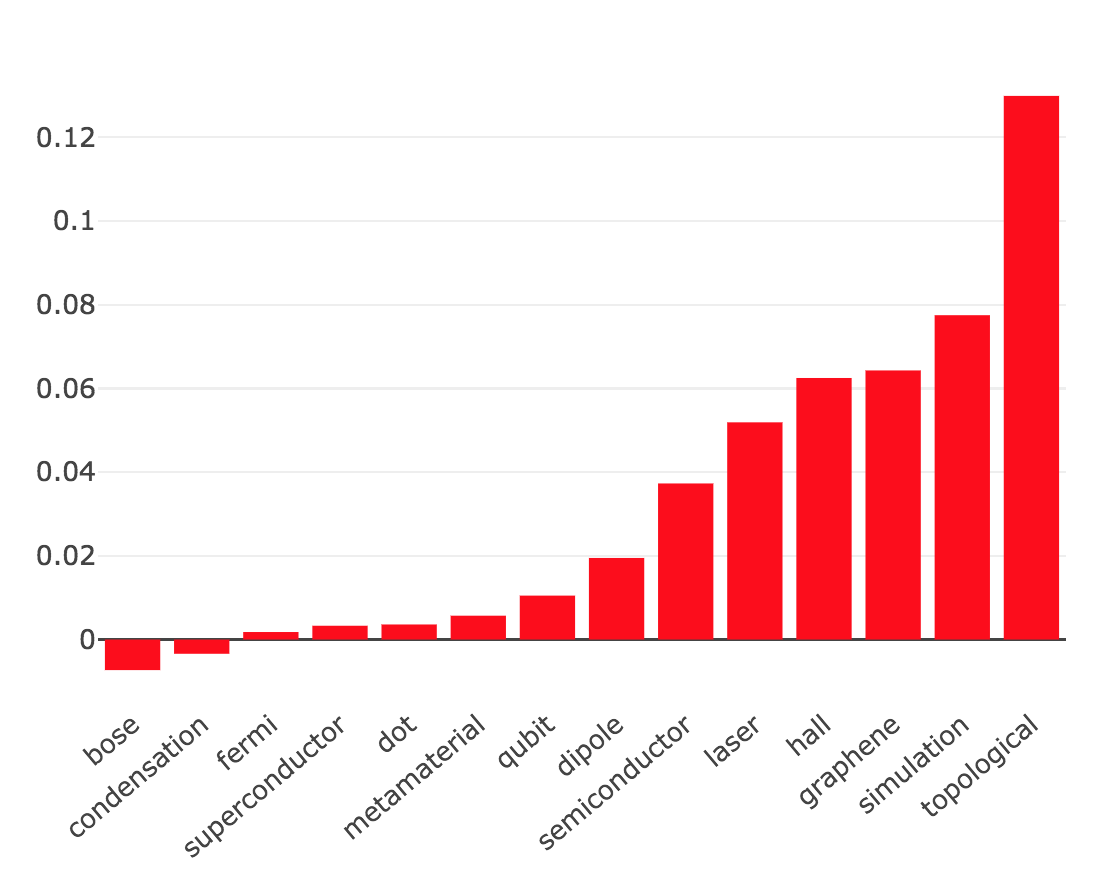
The difference in shares for the 2017th and 2010th years. (Note: the Nobel Prize in Physics in 2016 was awarded for the study of the topological phases of matter)
Next, based on the content of the texts, we build the word2vec model (for visualization it is better to take a window wider, 20 words). For each key, we take N nearest neighbors and with the help of t-SNE we calculate their 2D coordinates. See how the keywords relate to each other:

Cloud keywords and their satellites, N = 100. The further the Nth neighbor is, the more the word is highlighted. Relevant pairs: Graphene + Semiconductor, Qubit + Dot, Topological + Hall, Bose + Condensation
On arxiv there are subsections for each section. We find out in which subsections the keywords are found:
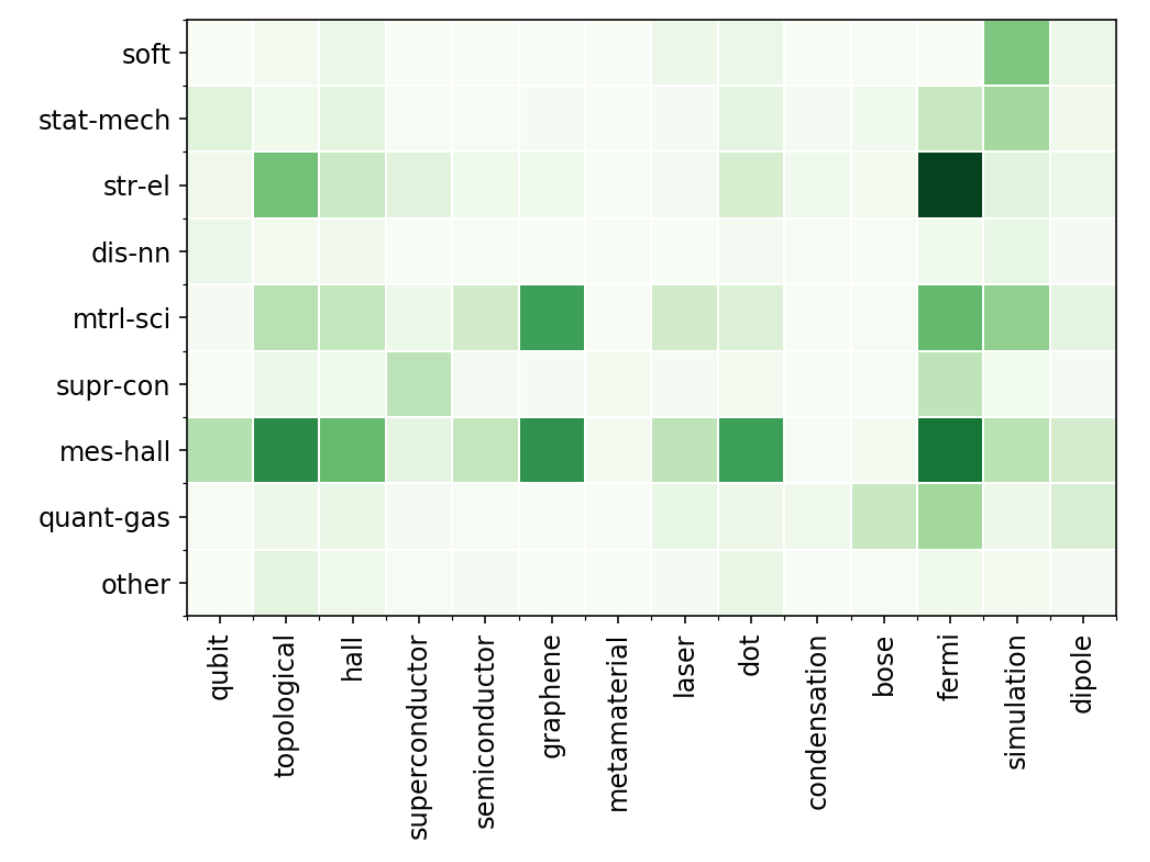
Deciphering the names of subdivision cond-mat The
above described work with a set of keywords that need to be compiled manually, however, some topics could be skipped. Let's build anLDAmodel and look at the topics:
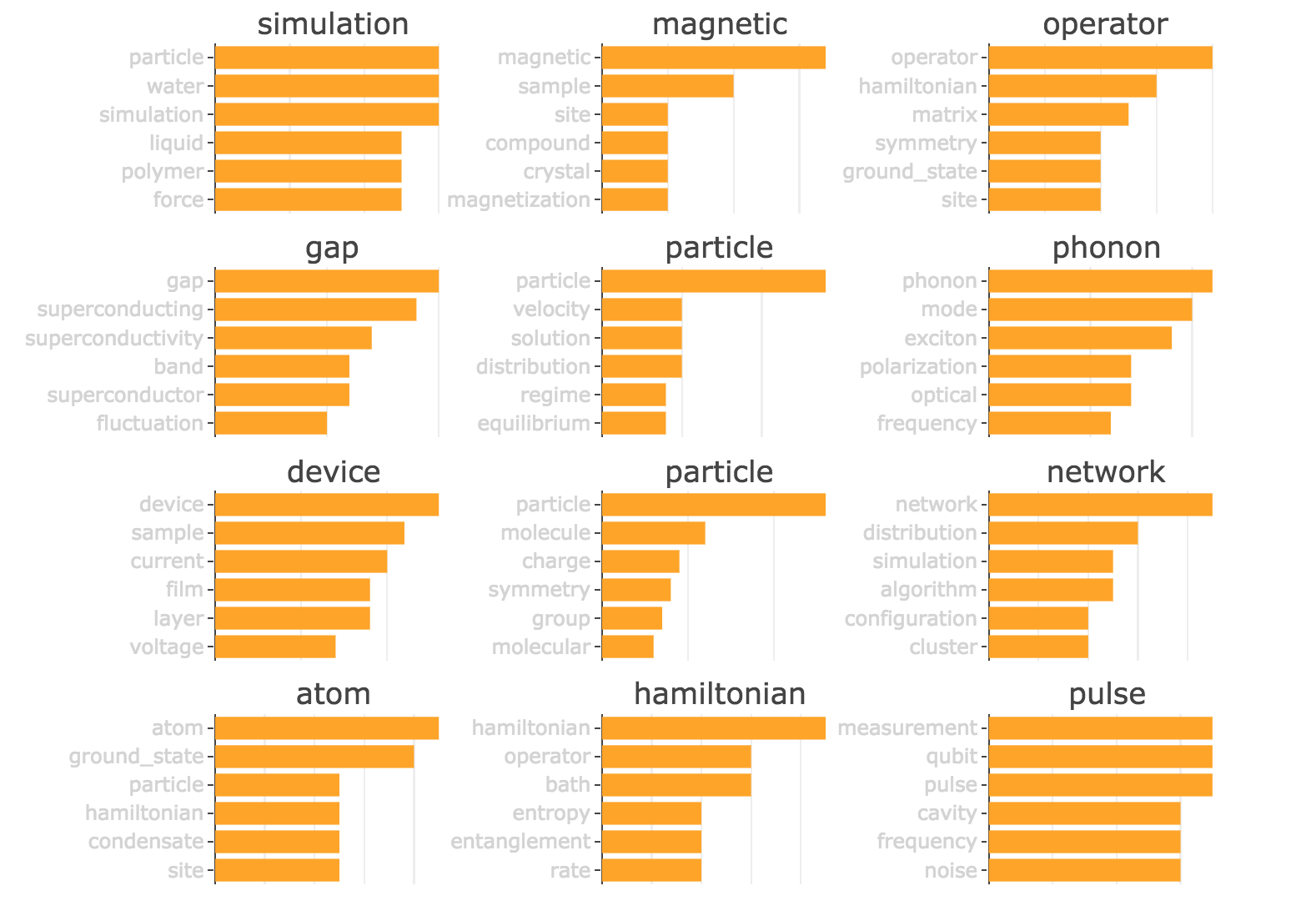
For each topic, we get a list of the corresponding articles:
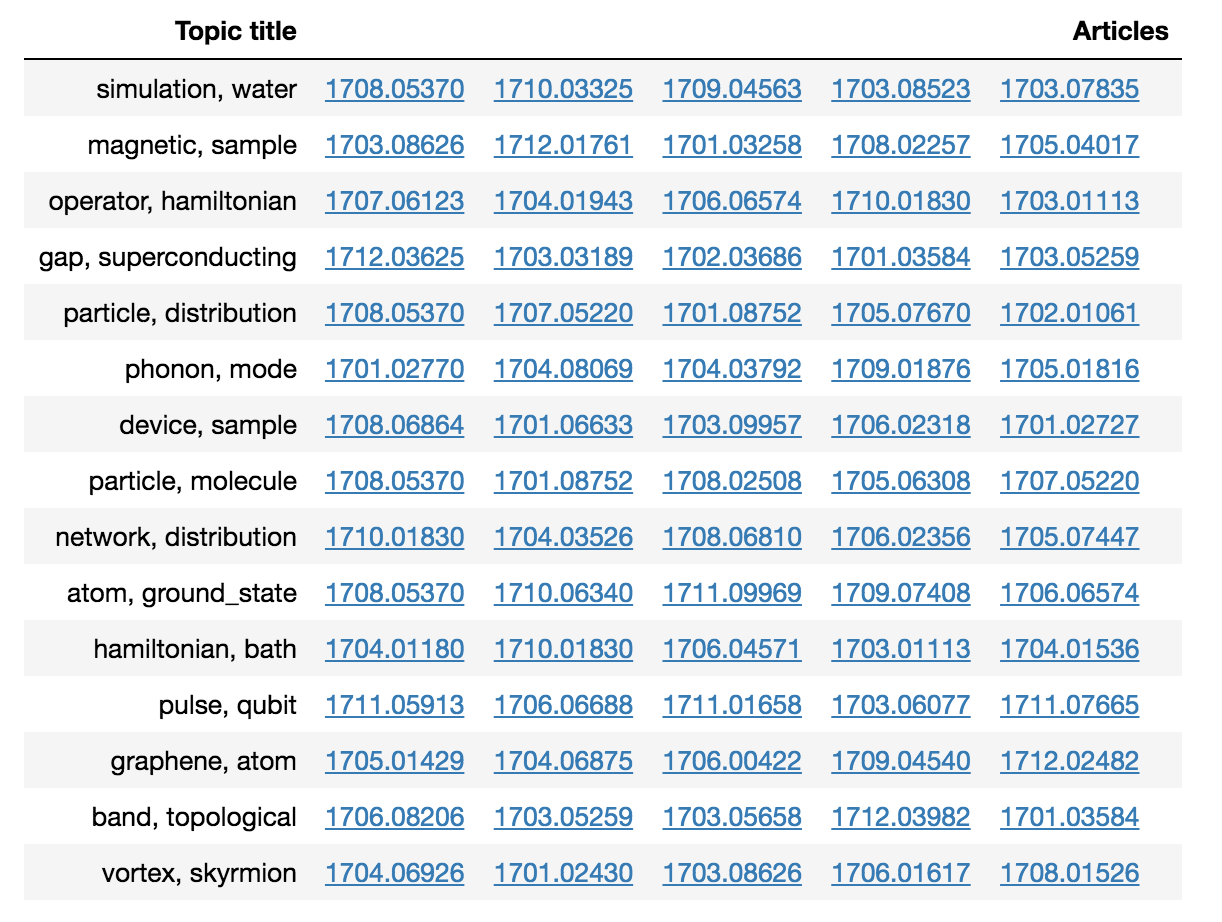
As you know, when reading articles it is always useful to examine the links. Can we collect some information about them? We can! Let's look at the "tail" of the text.
Tail
[23] L. Onsager, “Statistical Hydrodynamics,” Nuovo Cimento Suppl. 6, 279 (1949).
[24] R. P. Feynman, “Application of Quantum Mechanics to Liquid Helium,” Prog. Low Temp. Phys. 1, 17 (1955).
[25] P. C. Hohenberg and P. C. Martin, “Microscopic Theory of Superfluid Helium,” Ann. Phys. 34, 291 (1965).
[26] G. Blatter, M. Y. FeigelвЂman, Y. B. Geshkenbein, A. I. Larkin, and V. M. Vinokur, “Vortices in high-temperature super-
conductors,” Rev. Mod. Phys. 66, 1125 (1994).
[27] N. S. Voronova and Yu. E. Lozovik, “Excitons in cores of exciton-polariton vortices,” Phys. Rev. B 86, 195305 (2012);
N. S. Voronova, A. A. Elistratov, and Yu. E. Lozovik, “Detuning-Controlled Internal Oscillations in an Exciton-Polariton
Condensate,” Phys. Rev. Lett. 115, 186402 (2015) .
[28] A. Griffin, “Conserving and gapless approximations for an inhomogeneous Bose gas at finite temperatures,” Phys. Rev. B
53, 9341 (1996).
[29] A. A. Abrikosov, L. P. Gorkov and I. E. Dzyaloshinski, Methods of Quantum Field Theory in Statistical Physics (Prentice-
Hall, Englewood Cliffs. N.J., 1963).
[30] O. L. Berman, Yu. E. Lozovik, and D. W. Snoke, “Theory of Bose-Einstein condensation and superfluidity of two-
dimensional polaritons in an in-plane harmonic potential,” Phys. Rev. B 77, 155317 (2008).
[31] O. L. Berman, R. Ya. Kezerashvili, and K. Ziegler, “Superfluidity and collective properties of excitonic polaritons in gapped
graphene in a microcavity”, Phys. Rev. B 86, 235404 (2012).
[32] A. Amo, J. Lefr`ere, S. Pigeon, C. Adrados, C. Ciuti, I. Carusotto, R. Houdr´e, E. Giacobino, and A. Bramati, “Superfluidity
of polaritons in semiconductor microcavities,” Nature Physics 5, 805 (2009).
[33] J. P. Fern´andez and W. J. Mullin, “The Two-Dimensional Bose−Einstein Condensate,” J. Low. Temp. Phys. 128, 233
The PDF converter handles the bibliography section well. This means that links can be extracted using several regular expressions. As a result, we get a list of frequently cited, must-read articles.
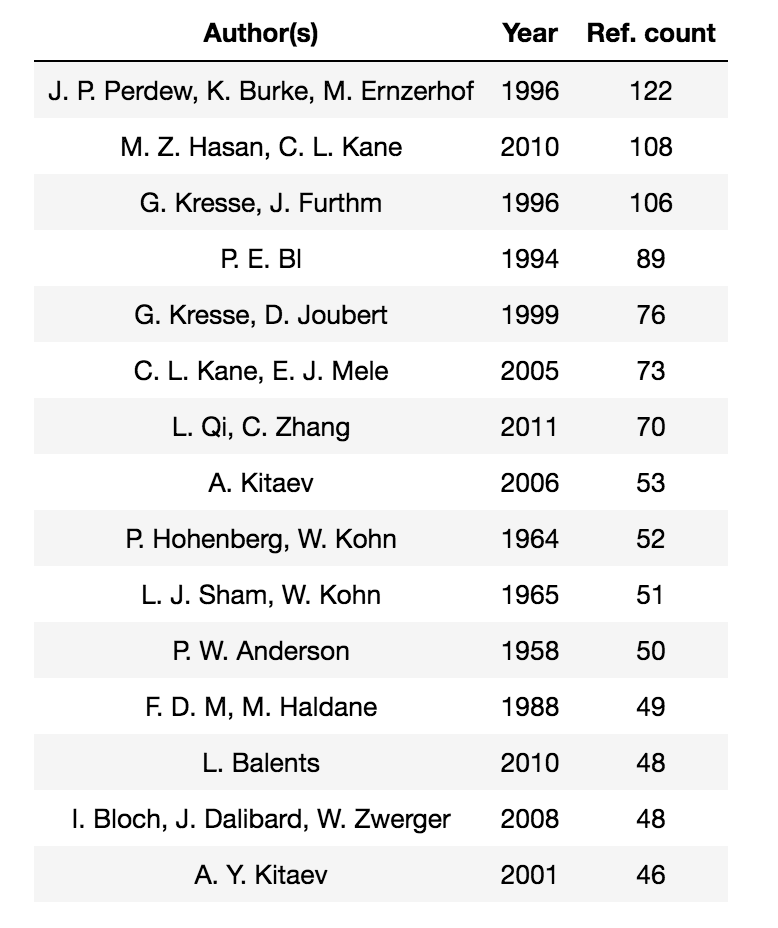
Check these links in Google Scholar :
- Pedrew, Burke, Ernzenhof, 1996 ~ 85 thousand citations
- Hasan, Kane, 2010 ~ 10 thousand citations
- Kresse, Furthmüller, 1996 ~ 44 thousand citations
- Kresse, Joubert, 1999 ~ 33 thousand citations
Make a list of the most active authors for each subsection - extract and count the contents of the author tag from the annotations. The number of articles published by a particular author is a characteristic that is clear, but unreliable, it can be supplemented with a median number of co-authors (see laptops).

The authors of the mes-hall are out of competition: their average rate of work is more than one article per week ...
Finally, we estimate the share of subsections:
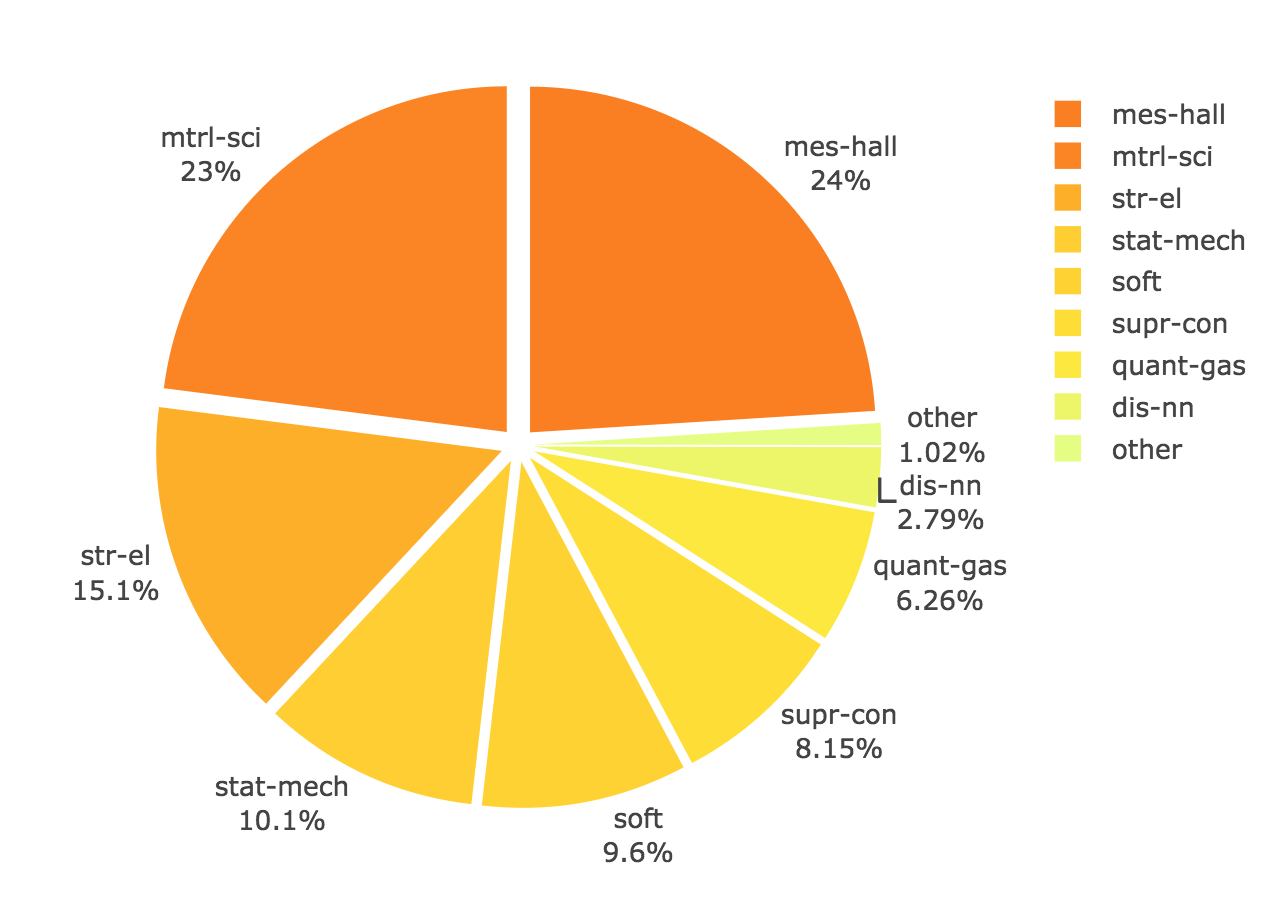
Demo laptops: cond-mat.17 , astro-ph.17 , cs.17 , math.17
GitHub: ilovescience
